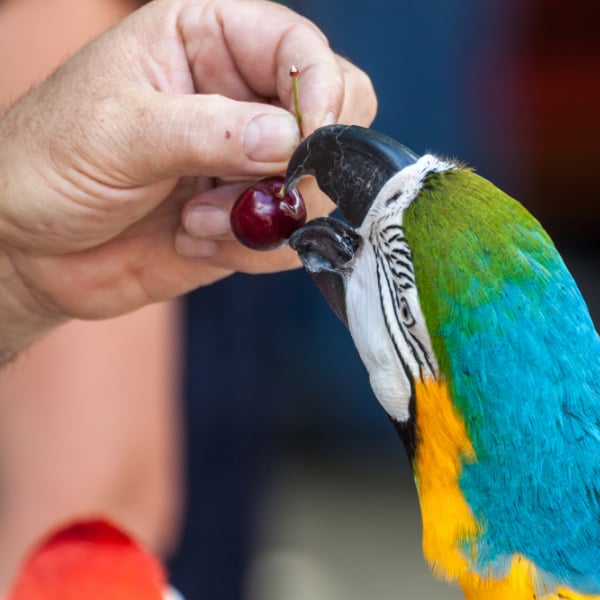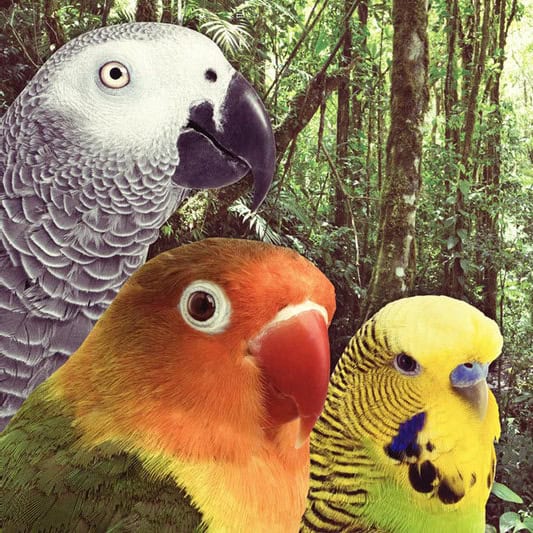Last Updated on by Catherine Tobsing
Dear Nora
How can you get your parrot to eat pellets? Birds can be difficult when trying new foods, I am reaching out to the company for their suggestions on conversion.
I will get back to you.
Hi Nora,
One of the problems we see is that birds get bored in general when simply eating out of a bowl full of food.
Hagen Alternative Formula parrot pellets might not be as pretty as fruit and flower shapes. Bright-colored puffs also may contain more sugar than other bird food manufacturers use for greater palatability.
You can easily start by sprinkling the Hagen Alternative Formula parrot pellets over her current food.
We found that encouraging foraging and enrichment can make feeding time more fun. Birds in general would prefer to work for food rather than eat out of a never-ending bowl.
Nora
My Hagen rep got back to me, she was out of the office.
Suggestions on encouraging a bird to try new pellets are no different than getting him to try other foods. I personally like to make food enticing and pique a bird’s instinct to forage. Try corrugated cardboard –poke the pellets into the folds of the cardboard.
For the sake of advanced expectations-put, this item near the cage-almost touching the outside.
Anytime I place something chewable near any of my birds’ cages, they automatically try to reach for it. (Lesson learned the hard way, yet put to good use afterward!)
Check out this video for suggestions!
The right cage choices, food dish placement, as well as optimal times to offer Tropican bird food pellets can make a big difference in encouraging our parrots to eat a minimum of 70% Tropican. Often caretakers offer too much variety in their bird’s diet and that not only contributes to improper nutrition, but these mistakes can also make diet conversion to Tropican very challenging.
What Else Can We Do to Increase the Consumption of TROPICAN?
Bird food doesn’t always have to be served in a dish! Our companion birds are very curious by nature-why not play into their natural foraging instincts with Tropican bird food diets? Check out the video on how to incorporate foraging toys, cat scratchers, and with optimal nutritional opportunities!
This should help, be patient. Try to pretend to eat some and let the bird steal yours.
Also, you can remove the seed dish at night, leaving only the pellet dish for night snacking. Then in the morning put the seed dish back in, and repeat nightly.
Quick Tips for Conversion to Harrison’s Bird Foods
1. Harrison’s Bread Mix or Tops Bird Bread Mix can be used as an extremely effective conversion tool. Food that the bird currently eats can be added to the mix and baked into the bread. Gradually reduce the amount of that food and replace it with the appropriate Harrison’s formula.
See: Diet Conversion: Small Bird
2. Change the bird’s environment. Try moving your bird to a new enclosure, such as a box, aquarium, or even a new cage. Remove all the toys, perches, and bowls and offer Harrisons High Potency™ on a solid surface of the floor.
3. Use a mirror or white paper. Sprinkling food over a mirror or sheet of white paper placed on the bottom of the enclosure works especially well for budgies. A bird old enough to be socialized may eat to compete with the “rival” bird in the mirror. A white paper background may draw attention to the food particles.
4. Slowly “wean” your bird from seeds. In the evening, offer seeds from the food bowl for only 1 hour. Then, remove the seeds and replace them with Harrisons High Potency. The next day, give your bird seeds for only 30 minutes in the morning and evening. On the third day, reduce the time to only 15 minutes twice a day. And finally, offer only High Potency™ on the fourth day. (Watch the bird’s droppings – not for budgies or finches)
5. Feed your bird at mealtime. Place the food on a plate, move it around with your finger or a spoon, and pretend to eat it in front of your bird.
6. Offer Harrisons Power Treats, Pepper Lifetime Coarse, or Adult Lifetime Mash. Birds love the taste of Power Treats™ and Pepper Lifetime Coarse.™ These foods can be crushed for smaller birds. Adult Lifetime Mash also has an appealing taste to help your bird try new food.
7. Use a converted bird as a role model. House your bird near another that’s already eating Harrison’s Bird Foods, or use a “trainer bird” in the same cage as a role model for eating.
8. Heat (warm) or moisten the food. Warm the High Potency slightly or moisten it with a small amount of fruit juice or other liquids.
9. Schedule a supervised diet change with your veterinarian. Some birds do not recognize Harrison’s as food, and placing the bird in a clinic where monitoring can be done will help keep your bird healthy through the conversion.
If the conversion steps don’t work the first time, you can feed the familiar food for a short time and then try again. The effort is worthwhile for the long-term health of your bird.
The bird’s weight (in grams), body condition, attitude, and droppings should be monitored carefully on a daily basis in small and medium birds and at least twice a week in large birds.
Note: Harrison’s conversion plan can be used for any pellets.
This is a thread from live support
Chatting with Guest
Visitor: How much of the Tops bird food is recommended for a blue and gold macaw daily?
You: as with most food bowls should be filled no more than 1/2 way – if they should go through it by eating as opposed to flinging – add spoke more to the bowl
You: we also recommend placing some in a dish and covering the food up with toy parts like vine balls and beads for enrichment.
Visitor: Thank you
The problem is that the question was too broad. It’s like asking “How much food should a human eat”?
That is why my short answer was to let the bird determine the amount of food he wants to eat on a day-to-day basis. We know that the bird was a blue and gold macaw which is a big bird requiring far more protein than a cockatiel.
We don’t know the sex which is important because a female bird who may be experiencing egg production needs more calories than a dormant male bird.
A molting bird requires lots of amino acids from protein to grow all those new feathers.
We don’t know if the bird is flighted or clipped. A bird that is flying across rooms in a home is going to burn more calories and needs more protein than a bird that is in its cage 20 hours a day.
Thus there is no single correct answer to the question “How much of fill-in-the-blank bird food should my bird eat”?
This is why we all need to learn how to “speak bird”. Your bird will give you the answers if you patiently wait, watch and encourage feedback.
Written by Mitch Rezman
Approved by Catherine Tobsing
your zygodactyl footnote
Author Profile
Latest entries
 The Traveling BirdJune 26, 2025Can You Name 5 Parrot Species That Are Living Wild in the USA?
The Traveling BirdJune 26, 2025Can You Name 5 Parrot Species That Are Living Wild in the USA? Bird BehaviorJune 26, 2025How is it Parrots Are Problem Solvers Social Animals and Even Use Tools?
Bird BehaviorJune 26, 2025How is it Parrots Are Problem Solvers Social Animals and Even Use Tools? Bird & Parrot AnatomyJune 25, 2025How a Tiny Chemical Modification Makes Parrots Nature’s Living Paintings
Bird & Parrot AnatomyJune 25, 2025How a Tiny Chemical Modification Makes Parrots Nature’s Living Paintings PigeonsJune 20, 2025How Do Parrots Thrive in Cities Outside Their Native Habitats?
PigeonsJune 20, 2025How Do Parrots Thrive in Cities Outside Their Native Habitats?




